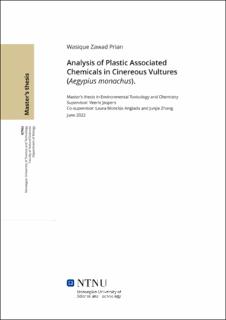| dc.description.abstract | Sammendrag
Plast er en oppfinnelse av vitenskap og teknologi som er nært knyttet til våre moderne liv. Uansett hvilket aspekt vi referer til, har plast en betydelig innflytelse som gjør ting enklere, raskere og billigere. Dette har ført til en enorm mengde produksjon av plast. Produksjonsindustrien prøver kontinuerlig å fremme produksjonsteknikkene sine, øker mengden samtidig som kostnadene reduseres. Håndteringen av plastavfall har imidlertid ikke økt sammenlignet med produksjon, og dette fører til at tonnevis med plastavfall strander i miljøet, og det øker hvert år med økende produksjon. Disse plastproduktene inneholder i mange tilfeller ulike tilsetningsstoffer for å øke verdien som produkt. Disse tilsetningsstoffene ender noen ganger opp med å forårsake alvorlige toksiske effekter på organismer etter å ha blitt eksponert. Oksidativt stress, hormonforstyrrelser er noen av skadene forårsaket av denne typen tilsetningsstoffer. Disse tilsetningsstoffene er kjent som plasttilknyttede kjemikalier. Ftalater og bisfenoler er to ofte brukte slike kjemikalier, og disse lekker ut i miljøet og blir tilgjengelig for både dyrelivet og mennesker. Disse forbindelsene forurenser også organismene etter direkte inntak av plast, og mange tilfeller er rapportert om slik oppførsel. Dermed forurenser disse myknere næringsnettet og kommer seg til toppen av næringskjeden. Det er fortsatt mangel på studier angående forurensning og skade på ulike organismer forårsaket av disse myknere. Dette inkluderer fugler som vanligvis brukes som et bioovervåkingsmiddel på grunn av deres høye trofiske posisjoner og følsomhet for miljøendringene.
Denne studien er rettet mot å undersøke tilstedeværelsen av ftalatmetabolitter og bisfenoler i gribbeunger i Spania utsatt for deponier. Siden plastisk forurensning av disse individene tidligere ble undersøkt, fokuserte målet med denne studien hovedsakelig på forurensning av myknere og deres korrelasjon med hverandre og biologiske faktorer. De tre biologiske faktorene som er undersøkt inkluderer individenes vekt, utviklingsdager og inkubasjonsdager. Blant de studerte ftalatmetabolittene ble fire av dem observert å ha konsentrasjoner over LOQ-nivåene (grense for kvantifisering). Disse fire metabolittene er monometylftalat (mMP), monoetylftalat (mEP), monoisobutylftalat (mIBP) og monobutylftalat (mBP) med gjennomsnittsverdier på 14,79 ± 4,65, 611,69 ± 191,73, 34,78 og 34,78 ± 37,27 ± 14,87 ng g-1 henholdsvis. Når det gjelder bisfenoler, ble bisfenol A (BPA), bisfenol S (BPS) og bisfenol Z (BPZ) funnet å ha den høyeste deteksjonsfrekvensen (DF). Ved beregning av korrelasjon mellom de biologiske faktorene og kjemikaliene ble det ikke observert noen signifikante korrelasjoner. Kjemikaliene i seg selv viste ingen korrelasjoner mellom dem da Spearmans koeffisientverdi varierte fra -0,0242 til 0,2396. Totalt sett ble tilstedeværelsen av ftalatmetabolitter og bisfenoler observert, men på grunn av mangel på studier utført på gribber eller rovfugler som helhet, ble det ganske vanskelig å sammenligne nivåene av disse to plasttilknyttede kjemikaliene og trekke en sikker konklusjon om forurensningstilstanden og potensiell risiko for eksponering i gribbene. | |
| dc.description.abstract | Abstract
Plastic is an invention of science and technology that is closely associated with our modern lives. No matter which aspect we refer to, plastic has a significant influence making things easier, faster and cheaper. This has led to an immense amount of production of plastics. The production industries are continuously trying to advance their production techniques, increasing the amount while decreasing the cost. The management of plastic waster however has not increased compared to production and this leads to tons of plastic waste being stranded in the environment and it is increasing every year with increasing production. These plastic products in many cases contain various additives to increase its value as a product. These additives sometimes end up causing severe toxic effects to organisms after being exposed. Oxidative stress, endocrine disruption are some of the damage caused by these types of additives. These additives are known as plastic associated chemicals. Phthalates and bisphenols are two commonly used such chemicals and these leach into the environment becoming available to the wildlife as well as humans. These compounds also contaminate the organisms after direct ingestion of plastics and many cases have been reported of such behavior. Thus these plasticizers contaminate the food web and make their ways to the top of the food chain. There is still a lack of study regarding the contamination and damage to various organisms caused by these plasticizers. This includes birds which are generally used as a biomonitoring agent because of their high trophic positions and sensitivity to the environmental change.
This study is aimed at to investigate the presence of phthalate metabolites and bisphenols in cinereous vulture nestlings in Spain exposed to landfills. As the plastic contamination of these individuals were previously investigated, the aim of this study mainly focused on the contamination of the plasticizers and their correlation with each other and biological factors. The three biological factors investigated include, weight of the individuals, development days and days of incubations. Among the phthalate metabolites studied, four of them were observed to have concentrations above the LOQ (limit of quantification) levels. These four metabolites are mono methyl phthalate (mMP), mono ethyl phthalate (mEP), mono iso butyl phthalate (mIBP), and mono butyl phthalate (mBP) having mean values of 14.79 ± 4.65, 611.69 ± 191.73, 34.8 ± 16.78, and 37.27 ± 14.87 ng g-1 respectively. In case of bisphenols, bisphenol A (BPA), bisphenol S (BPS), and bisphenol Z (BPZ) were found to have the highest detection frequency (DF). While calculating correlation between the biological factors and chemicals, no significant correlations were observed. The chemicals themselves did not show any correlations between them as the Spearman’s coefficient value ranged from -0.0242 to 0.2396. Overall, the presence of phthalate metabolites and bisphenols were observed but due to lack of studies conducted upon vultures or raptors as a whole, it became quite difficult to compare the levels of these two plastic associated chemicals and draw a definite conclusion of the state of contamination and potential risks of exposures in the vultures. | |
